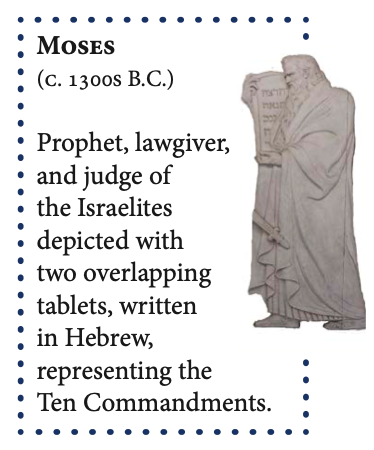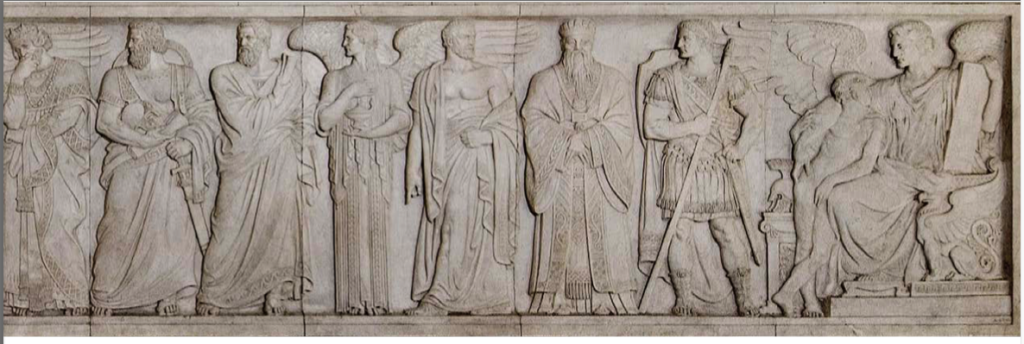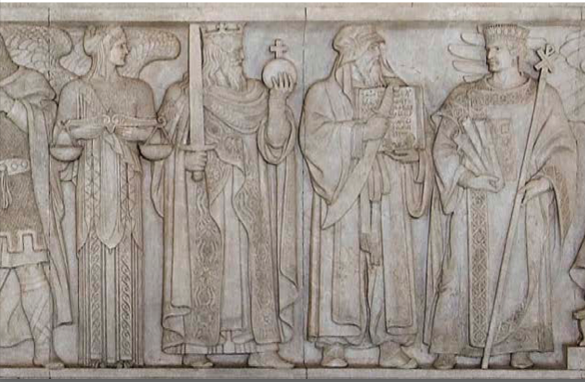LOVE, TRUTH, PEACE, FREEDOM AND JUSTICE
18 Lawgivers In U.S. Supreme Courtroom
Captured in artwork the representation of 18 great lawgivers on displayed on the walls of the United States Supreme Court. In the marble friezes are depictions of Rulers, Scholars and of course Prophets.

Cass Gilbert (1867-1934), architect of the Supreme Court Building, selected Adolph A. Weinman (1870-1952), a respected and accomplished Beaux-Arts sculptor, to design the marble friezes for the Courtroom. Weinman’s training emphasized a correlation between the sculptural subject and the function of the building. Gilbert relied on him to choose the subjects and figures that best reflected the function of the Supreme Court Building. Faithful to classical sources and drawing from many civilizations, Weinman designed a procession of “great lawgivers of history” for the south and north walls to portray the development of law. Each frieze in the Courtroom measures 40 feet long by 7 feet, 2 inches high and is made of ivory vein Spanish marble.
Weinman’s sculpture begins on the South Wall Frieze with “Fame” and moves from left to right. Included among the great lawgivers are allegorical figures whose names are included below the images in italics:
Menes (c. 3200 B.C.) First King of the first dynasty of ancient Egypt. He unified Upper and Lower Egypt under his rule and is one of the earliest recorded lawgivers. Menes is shown in the frieze holding the ankh, an Egyptian symbol for life.
Hammurabi (c. 1700s B.C.) King of Babylon credited with founding the Babylonian Empire. He is known for the Code of Hammurabi, one of the earliest known legal codes. The first stone of the Code depicts him receiving the law from the Babylonian Sun God.
Moses (c. 1300s B.C.) Prophet, lawgiver, and judge of the Israelites. Mosaic Law is based on the Torah, the first five books of the Old Testament. Moses is depicted in the frieze holding two overlapping tablets, written in Hebrew, representing the Ten Commandments. Partially visible from behind Moses’ beard are Commandments six through ten.
Solomon (c. 900s B.C.) King of Israel and renowned judge. His name, meaning “figure of the wise man,” has become synonymous with “judicial wisdom.”
Lycurgus (c. 800 B.C.) Legislator of Sparta. Lycurgus is credited with being one of the reformers of Sparta’s constitution. He left Sparta after convincing the Spartan leadership not to change his laws until he returned, but he never did.
Solon (c. 638 – 558 B.C.) Athenian lawgiver. He was appointed archon, an officer of state, and was charged with remodeling the Athenian constitution in 594 B.C. He was instrumental in codifying and reforming Athenian law, often revising the laws of
Draco. His name has come to mean “a wise and skillful lawgiver.”
Draco (c. 600s B.C.) One of Solon’s legal predecessors in Athens. Around 620 B.C., he committed an Athenian code of laws to paper for the first time. His code included many strict penalties and death sentences, often for what seemed to be minor offenses. Thus, the word “draconian,” meaning harsh or cruel, is derived from his name.
Confucius (551 – 478 B.C.) Chinese philosopher whose teachings stressed harmony, learning, and virtue. Within 300 years of his death, the Chinese State adopted his teachings as the basis for government. Although officially abandoned by the Chinese government in 1912, Confucianism continues to have an influence throughout the world.
Octavian (63 B.C. – 14 A.D.) or Augustus. First Emperor of the Roman Empire. He brought widespread reforms to many facets of Roman life. He supported the concept of using previous opinions of leading jurists to aid in resolving new disputes.

The North Wall Frieze proceeds from right to left, starting with “Philosophy”:
Justinian (c. 483 – 565) Byzantine Emperor from 527 until his death. He ordered the codification of Roman Law and published Corpus Juris Civilis. This work was instrumental in preserving Roman law and encompassed what has become known as the Justinian Code.
Muhammad (c. 570 – 632) The Prophet of Islam. He is depicted holding the Qur’an. The Qur’an provides the primary source of Islamic Law. Prophet Muhammad’s teachings explain and implement Qur’anic principles. The figure above is a well intentioned attempt by the sculptor, Adolph Weinman, to honor Muhammad and it bears no resemblance to Muhammad. Muslims generally have a strong aversion to sculptured or pictured representations of their Prophet.
Charlemagne (c. 742 – 814) or Charles I (the Great). King of the Franks and Roman Emperor. Charlemagne was reportedly an avid student who became an eloquent speaker of several languages and supported learning and literature throughout his realm. Under his leadership, most of Western Europe was united by 804 becoming the foundation for the Holy Roman Empire. He was also a reformer of legal, judicial, and military systems.

King John (1166 – 1216) born John Lackland. King of England from 1199 until his death. His policies and taxation caused his barons to force him to have his seal affixed to the Magna Carta. This document, depicted in the frieze as a scrolled document in King John’s hand, is regarded as the foundation of constitutional liberty in England.
Louis IX (c. 1214 – 1270) King of France who was canonized as St. Louis in 1297. He led the 7th and 8th Crusades and created the first court of appeals known as the “Curia Regis” or “King’s Court.”
Hugo Grotius (1583 – 1645) or Huig de Groot. Dutch scholar, lawyer, and statesman. He is depicted holding De jure belli ac pacis (Concerning the Law of War and Peace), one of the first books on international law, which he wrote in 1625.
Sir William Blackstone (1723 – 1780) English law professor and jurist. He wrote Commentaries on the Law of England (1765 – 1769), which has had a major influence on English and American Law.
John Marshall (1755 – 1835) Fourth Chief Justice of the United States, from 1801 to 1835. His 1803 opinion in Marbury v. Madison stated that the Supreme Court of the United States had the authority to determine the constitutionality of a law, establishing the power of judicial review for the Court.
Napoleon (1769 – 1821) Emperor of France from 1804 to 1815. He ordered and directed the recodification of French Law into what became known as the Code Napoleon or Civil Code. Published in 1804, this code formed the basis for modern civil law. Napoleon, at St. Helena, is reported to have said, “My glory is not to have won forty battles; for Waterloo’s defeat will destroy the memory of as many victories. But what nothing will destroy, what will live eternally, is my Civil Code.”

watch video and see guide for moo info. Peace
Video Tour of the US Supreme Court
